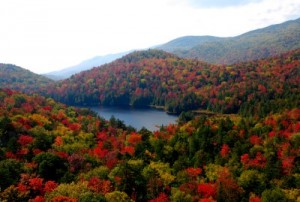Many thanks to Paul Hetzler, CCE St. Lawrence County, for permission to use this piece.
It turns out that, in terms of fall foliage, the color of too dry is officially known as “blah.” This would undoubtedly be the least popular color selection if it was included in a jumbo pack of Crayolas. Basically, it is a jumble of faded hues with a mottled brown patina throughout. This year’s dry summer could mean that “blah” may feature prominently in Mother Nature’s fall hardwood forest palette.
Why would a prolonged lack of moisture affect autumn color? Let’s look at what makes leaves colorful in the first place. Among the things we learned — and probably forgot right away — in Junior High Biology is that leaves are green because of chlorophyll, the amazing molecule that converts light, water and carbon dioxide into sugar and oxygen. Its intense green tends to mask colors such as orange and yellow that are present in leaves in lower concentrations. When chlorophyll dies off in the fall, those “weaker” colors are revealed.

It’s not like yellow and orange are just randomly painted on the insides of leaves, though. Molecules other than chlorophyll are involved in various metabolic pathways within a leaf, and they happen to be colorful. By comparison, we are boring. Our hemoglobin is red, at least in the presence of oxygen, but we are not as flamboyant on a cellular level as leaves are.
Red, however, is a horse of a different color where leaves are concerned. Trees spend energy that they would otherwise save for next year’s growth to make the molecule responsible for red. It is called anthocyanin, mostly because short words embarrass scientists, and it is “expensive” for trees to make. No one knows why trees do this. OK, there are some explanations out there, but they are so flimsy they don’t even hold up in the rain.
In wintertime, I make my own bread. Although quality varies because I never use a recipe, more than likely the bread would turn out worse than usual if I omitted water. Similarly, all the ingredients need to be there for photosynthesis to work properly. When water is in short supply, production at the sugar factory, also known as the chlorophyll molecule, drops off sharply.
Without sugars, many cellular processes slow or even stop. Damaged chlorophyll is not replaced, and that deep forest-green color starts to pale. Those yellow and orange molecules (xanthophylls and carotenes, if you are insecure about word length) also begin to disappear.
As trees dry out further, their leaves start to brown along their edges. This is called marginal scorching, not to be confused with marginally scorched, which describes my bread. In drought-prone locations with thin soils, some tree leaves will entirely brown and turn crisp, calling it quits for the year. This of course is not good for trees, because they are not able to plug up the vascular connections between leaves and twigs, making them prone to even more desiccation over the winter.
As if that isn’t enough sepia tones for one season, our sugar maples once again are looking tawdry due to yet another infestation of the native maple leafcutter. This is a tiny colorful moth whose newly hatched larvae eat circular patterns inside leaves, eventually getting big enough to emerge onto the leaf surface and excise little holes in it to make a mini turtle-shell case for itself. A single infestation causes only minor harm to the maples, but repeated infestations can weaken them somewhat.
Between marginal scorch, brown leaves, holey maples and a general shortage of leaf pigments, we might not get the brightest display this fall. Cool nights and sunny days tend to favor the production of red in the few tree species capable of producing it, and this could at least offset the brown tinge that infuses our woodlands at present. Here’s hoping for a good crayon selection this autumn.
The IPM Connection? Well, you can’t run the well dry trying to keep your trees happy. But worse yet would be thinking your trees have some horrid disease and it’s time to dash over to the garden center for a jug of fungicide. In this case you’ve got two fundamental IPM precepts to guide you now and for the future: an accurate diagnosis and preventive action.
- Identify (i.e. diagnose) your problem before you act. Trees that look sick or pest-ridden could suffer instead from to a surfeit or lack of three critical things their fine feeder roots need: the oxygen, water, and nutrients. Because if those roots aren’t happy, neither is your tree.
- Prevent the problem: learn which trees will work for your landscape and how to help them deal with the hand Nature deals them. Right plant, right place, proper care: these help reduce infestations and impacts of pests.
Check out this helpful guide.